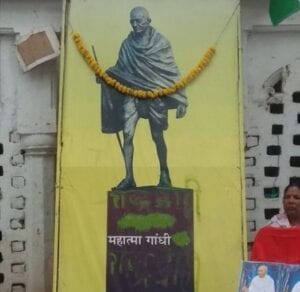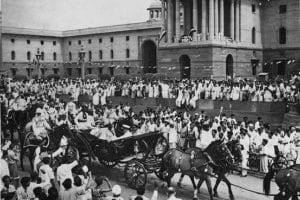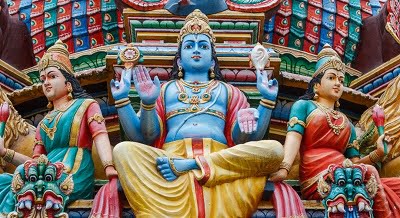the third largest religion in the world and is the oldest among major religions. Historians believe that it originated more than 5000 years ago. Hinduism is the first Dharmic religion. It is often referred to as “the religion of India;” about 800 million of the world’s billion Hindus live in India, so about 80 percent of Hindus are Indians. According to a recent American survey, Hindus are the best educated and among the richest religious groups in the United States.
Hindus believe in reincarnation and eventual communion with Brahman (God) as well as respect for all life forms. Their holy writings are known as the Vedas. Hindus outline the four goals of various humans (purusharthas) as: dharma (righteousness), artha (material success), kama (love/pleasure), and moksha (release from reincarnation/reunification with Brahman); above all four of these, in certain Hindu schools, is the goal of pure Love of God.
Definition by law
In 1966, the Supreme Court of India defined what Hinduism is for legal purposes:
- Belief in the authority of the Vedas (an ancient collection of hymns to the gods, written in Sanskrit). The oldest collection of hymns in the Vedas is the Rig Veda, which was written between 1800 and 1300 B.C. The greatest Veda hymn is the “Bhagavat Gita,” a section in the Mahabharata concerning life’s never-ending spiritual journey towards perfection. Bhagavat Geeta is rendered as a dialogue between Shri Krishna (incarnation of Vishnu) and Arjuna (the great archer) in the middle of the battlefield.
- Spirit of tolerance and willingness to understand and respect an opponent’s view.
- Belief in world rhythms: long periods of creation, maintenance and dissolution follow each other in endless succession.
- Belief in reincarnation (rebirth) and preexistence.
- Belief that there are many ways to salvation.
- Unlike most other religions, Hinduism is not defined by a specific set of philosophical concepts.
- Belief in one god. Contrary to popular belief, Hinduism is not a polytheistic religion. The Vedas, the primary Hindu holy scriptures states that there is only one God but can manifest in many forms. This is the reason why there are many deities. A common example used to explain this is that an individual can be called different names depending on the relationship has with another. A man can be a son to his parents, a nephew to his uncle, a father to his son, and a husband to his wife all at the same time. None of these different relationships suggest multiple people but rather different aspects of one person. The same is applied to God in Hinduism, which has no form and is infinite. Hindus may call God, Paratman (Supreme Soul), Brahmana (Eternal Spirit), or Ishvara (Supreme Lord). Deities have various names but represent aspects of God that manifest in the world. For example, Agni (fire, Divine spark), Vayu (wind, or breath which could mean life force), Indra (in mythology king of gods but also refers to the senses such as vision, hearing, touch, taste), and Lakshmi (fortune).
- Secular multiplicity and accommodating flexibility in spiritual practices.
Relations between Hinduism and Christianity have also been shaped by unequal balances of political power and cultural influence. Although communities of Christians have lived in South India since the middle of the 1st millennium, the great expansion of Indian Christianity followed the efforts of missionaries working under the protection of the British colonial government.
Some state governments such as Gujrat, Madhya Pradesh have passed anti-conversion laws, attempting to prevent Hindus from being forced or coerced into converting to other religions such as Islam and Christianity.
For more on Hinduism, see World History Lecture Three.
Believer?
In Hinduism, according to one classification, believers are categorized into four distinct categories, according to their beliefs.
- Advaita Astika: Believer of God & Believer of Scripture
- Advaita Nastika: Believer of God & Non-believer of Scripture
- Dvaita Astika: Non-believer of God & Believer of Scripture
- Dvaita Nastika: Non-believer of God & Non-believer of Scripture
Issues
Sati
Sati is an old practice, it’s practice is forbidden by the Hindu scriptures in Kali Yuga, the present age.[7] In this practice the widow was immolated alive on her husband’s funeral pyre, although the practice was made as per the agreement of the widow. However, during the Islamic invasion of Indian subcontinent, this practice revived, as rapes, abduction were normally carried out by Islamic invaders.[8][9] To this day, the practice remains illegal in India.
Caste system
Caste system is neither unique to Indian society or limited, it has been prevalent in many parts of world, such as “Al-Akhdam” of Yemen, “Songbun” of North Korea, and others.
It’s apart from religion, but closer to practical life. The book Manusmriti texts contains varnas based on profession. Traditionally Hindu society is divided into four castes:
- Brahmin (the highest class)
- Kshatriya (the warrior or ruling class)
- Vaishya (merchants)
- Shudra (unskilled laborers and servants)
Originally, caste was determined by profession, and could be changed by changing career. With the start of British colonization, caste system established by British and caste became defined by birth.
Shudras were the lowest caste and were denied of many rights in past. Apart from these four main castes, there was a new addition in the modern distortion of the caste system, as the lowest caste called the Dalit (Untouchables). Historically these dalits are the victims of discrimination by higher castes, to this day. Despite this, there has been large amount appreciation towards the caste system, especially because it differed from the racial system such as casta of Spain, admirers includes the notable personalities such as Annie Besant, P.D. Ouspensky, Pandurang Shastri Athavale and Sarvepalli Radhakrishnan. Friedrich Nietzsche is noted to have said “Close the Bible and open the Manu Smriti.”
Hinduism and abortion
The teachings of Hinduism exact non-violence. Hinduism is generally opposed to abortion except if the life of the mother is at risk.
Source: https://conservapedia.com/Hinduism
DONATE to Conservapedia
Why is the cow sacred to Hindus?
(This article was written by Indian scholar Murali Chemuturi)
Hindus, Jains, Sikhs and some Buddhists consider the cow to be sacred so much so that they worship it. Why is it so? Is it some blind belief or superstition? Is it because of some mysterious powers the cow enjoys and grants them to its worshippers? Mystical powers are indeed attributed to a cow by its devotees. It is very difficult to prove them as is the case with most miracles. But it has real physical powers and it is easy to prove them. In fact, some of its powers are already recorded.
For example this web site records the benefits of cow’s milk.
Even WHO finds that cow milk is the best (http://www.whfoods.com/genpage.php?tname=foodspice&dbid=130 )
What is widely believed and personally seen by me are the benefits that I enumerate here. But before moving further, cows come in many varieties and are fed with differing diets. Cows are natural herbivores. But they are fed with manufactured feed with added chemicals and meat/beef/pork to increase milk production. Cows come in two varieties mainly with a hump and without a hump. Cows with a hump are local to India but are found in other Asian countries. Cows without hump are local to Europe and are found everywhere including in India. European cows give much more milk than Indian cows. When I refer to the benefits of cow milk, I am referring to Indian cow that has a hump.
I am enumerating here the benefits of cow milk. First, it is the closest alternative to mother’s milk for an infant. Even a day-old infant can ingest and digest cow milk without any issues. Second, regular and continued use of cow milk in daily food intake increases the immunity of the individual. Here I give a personal example. My grandson who was born in USA was having health issues for more than a year. He was having ear infection and fever at least once a month. He was operated in the ear and some tubes were inserted to prevent ear infection. He came to India recently. I was terrified; the hygiene is worse here; the air quality is worse; the water quality is bad. All people coming from USA to India, even if they are Indians, drink only bottled water. There are mosquitoes on top of everything. Our homes are not insulated and we keep our doors open all day. But, thank God, he stayed for three months and did not suffer with ear infection or fever even one single day. We never had to visit a doctor. The difference, we use cow milk every day along with other cow products which I am going to enumerate below.
The second cow product is the ghee. Ghee is virtually unknown to Americans. It is produced by heating the butter. When butter is heated at moderate temperatures, it becomes a liquid like oil. Butter cannot be stored long outside the fridge. Ghee can be stored outside the fridge for as long as you want. Regular consumption of ghee of about four ounces (about 100 grams) everyday will increase the immunity in the person so much so, that no disease can attack him. Another personal example, I cite here. In the year 2000 I suffered a malady and was hospitalized. I lost 70% of my eyesight and totally the capacity of spatial orientation. I could not locate bathroom from my bed room in a house, I built! It resulted in diabetes. It took about two months to improve my eyesight where I can see with the help of highest powered glasses. Worse, I lost a large part of my memory. I lost my knowledge of information technology which was my profession. I was getting insulin shots for my diabetes. Then I started consuming cow ghee from 2004. By 2007, my eyesight was fully restored and I do not have to use even reading glasses even now and I am 63 years old! Fluorescent light is adequate for me to read the newspaper. I regained my knowledge. I developed a few software products which sold internationally though in a small quantity. I do not receive any customer complaint from my clients. Beginning with 2008, I authored five books on IT and one book on Personality Engineering and translated Indian epic Raamayana! I also authored many technical and other papers which are read by more than a hundred thousand people all over the world. Nobody is yet to pan my articles as junk. I attribute the spurt in my intellectual capacity to cow ghee.
Third is cow’s curds. Eating rice mixed with cow curd will increase the thickness and rebuilds the stomach lining. It will prevent and cure (albeit very slowly) the stomach ulcers. Any other curd with rice induces sleep but cow curd makes one very alert.
Fourth is the urine of the cow. Don’t thumb your noses, please! It is a panacea. There was a poor man near my house and he suffered a massive heart attack when he was about 50 years old. He is too poor to pay for the wonderful modern medicine. Hospital discharged him after the initial week as he was not able to pay for his treatment. His wife collected urine from the cows and fed it to him at least once a week for a year. She gave him half a liter per dose. He lived on for 25 more years an almost healthy life and died of old age at 75! When I was sick and afflicted with diabetes and taking insulin I was at my wit’s end not knowing how to improve my condition. Then one day a cow came in front of my house and urinated. My wife collected a glassful (about half a liter) and fed it to me. Believe it or not, I began improving. That made me switch to cow milk and cow ghee. Even this article is a result of that.
Fifth is the cow dung. Perhaps, that is the only excrement of an animal including human beings that has a nice aroma. It has disinfectant properties. Until recently, the front yards of Indian houses used to be sprinkled with water mixed with cow dung to prevent infections. There is a city in India named Vaaraanasi or Benares. It is perhaps the filthiest city in the world and it is the most sacred place for Hindus. While it is so filthy, the city is perhaps the only city in India to be free of mosquitoes! I visited that place with dread in my heart about the probable damage to my health but surprisingly I was not affected at all. How so? Cows roam the streets of Vaaraanasi freely, urinate and defecate at every place. The roads are filled with cow urine and cow dung which prevent all germs from spreading and destroy them. So the city remains healthy. I came back healthier. It is also used as medicine in Ayurveda system of medicine.
Cow dung is made into cakes and dried. Then they are used for cooking in homes. The fire from the cakes of the cow dung produce intense heat to such a level that they are used for smelting ores to extract metals in India till recently. Second the smoke from the fire of the cow dung cakes has a pleasant aroma besides acting as a disinfectant to dispel mosquitoes. They also burn longer. The cake of the cow dung is much better than any firewood for cooking or superheating. The ashes that come from burning the cakes made of cow dung has medicinal properties. When you apply it to your body, mosquitoes or other insects do not approach the person or bite him. That is why the ascetics of India apply those ashes generously to their body. Another excellent use of those ashes is to polish gold ornaments and the glass. If you clean the windshield of a car with those ashes, the glass not only becomes spotlessly clean but also do not allow water to stick to the glass or obstruct your vision during rainfall.
Why are scientists not able to discover these benefits? Research is funded by businesses. They want results in a short time say one or two years. At most they may wait for five years. To produce a statistically significant sample of results longer periods of study is required. Only empirical studies are possible from past records. And these are not available.
You can check all these facts. A visit to Vaaraanasi would convince you. But as I repeat the cow must be of Indian variety with a hump; it should be fed only grass; and it should be allowed o roam freely. You may ask why I did not take these from the beginning. The reason is that cow ghee and milk are very costly. Now, cow urine is not available freely – it is bottled and sold. When something is bottled, I suspect dilution and adulteration. Even cow dung is sold. Are these products available in USA? Cow ghee is available in Indian stores across USA and it is of good quality. Cow milk and curds are perhaps not available. Unless cows are there, urine and dung are not available. But cow ghee alone is very potent.
That is the reason why the cow is considered sacred and worshipped.
Chronological History of Events Related to Hinduism

The Babri Mosque ruling in India

Report: India Suffers ‘Record Number of Violent Attacks Against Christians’

Gandhi’s Ashes Stolen, Posters Defaced at Burial Site on His 150th Birthday

Report: 2019 World Watch List Released Exposing the Top Countries who Persecuted Christians in 2018

Study Shows Christians Continue to be the Most Persecuted Religion with 90,000 Christians Killed for their Beliefs Worldwide in 2016

Tony Blair Faith Foundation created for Advancement of One World Religion

India’s Independence Day is Declared from Britain, but Did India Really Become Independent?




